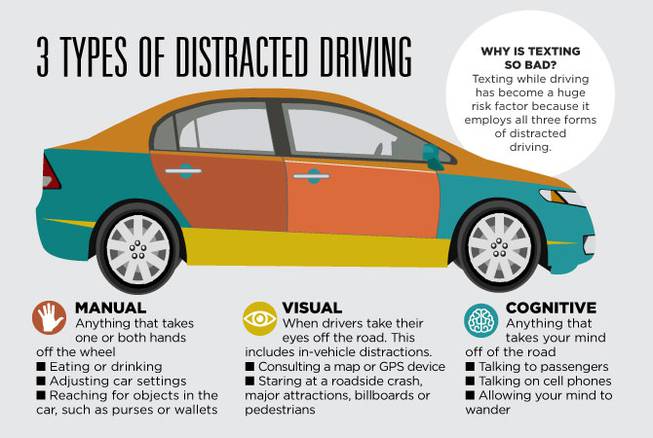
Sunday, March 29, 2015 | 2 a.m.
Even before cellphones, GPS devices and complicated dash boards, distracted driving was inevitable.
Our eyes scan, our minds wander, and most drivers reach a point where the process of driving becomes second nature, and we stop paying attention as we should.
Now, as technology evolves, distracted driving is even more common. The good news is, it’s also preventable.
The 3 types of distracted driving are...
Manual
Anything that takes one or both hands off the wheel, such as eating or drinking, adjusting car settings, or reaching for objects in the car, like purses or wallets.
Visual
When drivers take their eyes off the road. This includes in-vehicle distractions, such as consulting a map or GPS device, as well as external distractions, such as staring at a roadside crash, major attractions, billboards or pedestrians.
Cognitive
Anything that takes your mind off of the road, such as talking to passengers, talking on cell phones, or simply allowing your mind to wander.
Why is texting so bad?
Texting while driving has become a huge risk factor because it employs all three forms of distracted driving.
Your eyes are off the road while texting for an average of 5 seconds. If your vehicle is traveling 55 mph, you will travel 100 yards during those 5 seconds.
So, think about it like this: Imagine a football field populated with vehicles in multiple lanes of traffic, moving in both directions, while pedestrians are walking the sidelines. Then, imagine having to drive the length of it blindfolded.
That’s the risk while texting and driving.
Texting while stopped still distracts your brain while moving
There’s a misconception that there is little harm in texting if you’re stopped at a red light. Not only is doing so illegal, it also poses a substantial risk for cognitive distraction.
Once the light turns green, you may have finished sending your text, but your brain still is processing the conversation and anticipating the forthcoming response. Your phone probably still sits in your hand and your eyes likely are darting back and forth to the screen.
Texting while driving limits all your primary functions and impairs your cognitive processing.
Teens on the road
Young, inexperienced drivers are more likely to be involved in texting-related crashes, as they are more likely to engage in other risky driving behaviors, such as driving drunk or riding with drunk drivers.
For any age
Your chances of a distraction-related crash if you are texting, emailing or messaging while driving is 3 times higher.
Do hands-free devices promote safer driving?
Though hands-free telephone devices have helped remove the physical distraction of cellphone usage, they still limit your cognitive function while driving.
When your mind is somewhere else — say, focused on a conversation — you are far less likely to be able to anticipate the unexpected.
How to avoid distracted driving
While most of us are properly inundated with warnings about distracted driving, a large majority of us still are guilty of doing it. Even careful drivers make exceptions or one-time excuses, but once is all it takes.
Here are tips to keep temptation at bay.
1. Take a couple of minutes before you get in the car to prepare for your trip, no matter the distance.
2. Turn your phone off, to airplane mode or to silent, and leave it out of sight or face down to prevent compulsive checking.
3. Program your destination into a GPS before you start driving.
4. Create and frequently update a playlist with the songs you want to listen to while driving so you won’t be compelled to change the music en route.
5. Secure children and restrain pets. If you have to assist them while driving, pull over.
6. Store loose objects in the vehicle to prevent them from rolling around, falling over or spilling.
An unruly child or an unrestrained animal also can create a manual distraction for a driver if the situation requires a physical response.

Join the Discussion:
Check this out for a full explanation of our conversion to the LiveFyre commenting system and instructions on how to sign up for an account.
Full comments policy